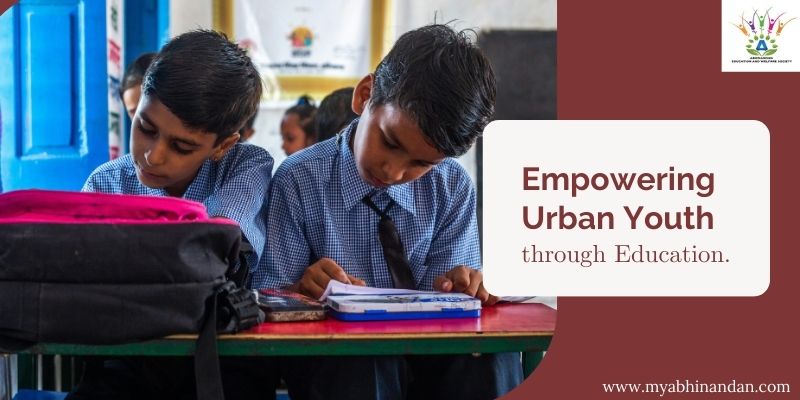Urban education in India is a landscape filled with both opportunities and challenges. While cities boast a higher density of schools and educational institutions, the reality for many urban students is far from ideal. Overcrowded classrooms, insufficient resources, and a lack of personalized attention are just a few hurdles that urban schools face. However, during these challenges, Non-Governmental Organizations (NGOs) are playing a transformative role. They are not only filling gaps but also driving innovative solutions to uplift urban education. NGOs are stepping in, bringing with them a wave of change through targeted interventions and creative programs. The best NGO for education is often the one that addresses specific local needs effectively, making a significant difference in the lives of urban children.
The Landscape of Urban Education in India
The current state of urban education in India presents a mixed picture. On one hand, cities have better infrastructure compared to rural areas. Statistics show higher enrollment rates and better teacher-student ratios in urban schools. However, these numbers can be misleading. The quality of education often suffers due to overcrowded classrooms, inadequate teaching materials, and a lack of trained teachers.
Urban students face a myriad of obstacles. There is a major problem with overcrowding in classrooms, with classrooms filled beyond capacity. Resources like books, labs, and libraries are often outdated or insufficient. There is also a significant gap between the educational experiences of students from different socio-economic backgrounds. While some have access to private schools with state-of-the-art facilities, others rely on underfunded public schools. The stark contrast between the two demonstrates the need for urgent interventions to close this gap and promote inclusive education.
NGOs to the Rescue
Amid these challenges, numerous NGOs have stepped up to support urban education. Organizations like My Abhinandan, Teach For India, and Akanksha Foundation are at the forefront of this movement. These are some of the best NGOs for education in India, known for their impactful work.
My Abhinandan, for example, has made significant strides with its Read India campaign, which focuses on improving basic literacy and numeracy among children. Teach For India recruits bright young graduates to teach in under-resourced schools, bringing energy and innovative teaching methods. The Akanksha Foundation runs schools and after-school centers, providing holistic education and life skills to children from low-income families.
Take the case of Suman, a student from a slum in Delhi, who struggled to read at grade level. With the intervention of Teach For India, she not only caught up with her peers but also excelled, developing a love for reading. These success stories are a testament to the impact NGOs working for education can have.
Innovative Approaches by NGOs
NGOs are not just addressing the symptoms but are also pioneering innovative approaches to tackle the root causes of educational disparities. Digital learning platforms, interactive teaching methods, and experiential learning are some of the tools they employ.
For instance, the Digital Equalizer program by the American India Foundation uses technology to enhance the learning experience in classrooms. Interactive software, digital content, and teacher training are making education more engaging and effective. NGOs are also focusing on inclusivity, ensuring that children with disabilities receive the support they need.
Special education programs by organizations like Sense International India provide tailored support to visually and hearing-impaired children, integrating them into mainstream education. These innovations are not only improving academic outcomes but also fostering a more inclusive and equitable learning environment. The role of NGOs in inclusive education cannot be overstated, as they help create opportunities for all children, regardless of their abilities or background.
Empowering the Community

Sustainable change requires the involvement of parents and local communities. By engaging with parents, they ensure that the value of education is recognized and prioritized at home.
Programs like Parvarish by Save the Children work closely with parents, offering workshops on parenting skills and the importance of education. Several NGOs also run programs aimed at empowering and educating women. Educating women creates a ripple effect, improving the educational prospects for the entire family. Education for underprivileged children is often more effective when the whole community is involved.
Community-led initiatives are another powerful tool. For example, in the slums of Bangalore, community members have come together to run after-school tutoring centers, supported by NGOs. These centers provide a safe and conducive environment for children to study, away from the chaos of their homes.
Challenges and Limitations of NGO Efforts
Despite their significant contributions, NGOs face numerous challenges. Funding is a perpetual issue, as they rely on donations and grants, which can be inconsistent. Policy barriers and bureaucratic red tape often hinder their operations.
Moreover, the scale of the problem is immense, and while NGOs make a substantial impact, they cannot address all the issues alone. There is a pressing need for stronger collaboration between the government, private sector, and NGOs. Public-private partnerships can help pool resources and expertise, amplifying the reach and effectiveness of educational interventions.
The Way Forward
To scale up successful NGO models, there must be a concerted effort to increase funding and streamline policy support. Government policies should encourage and facilitate NGO initiatives, removing unnecessary obstacles.
Additionally, there should be a focus on replicating successful models across different urban centers. Sharing best practices and creating platforms for collaboration can help NGOs learn from each other and implement effective strategies more broadly.
As individuals, we can also play a part. Supporting NGOs through donations, volunteering, and advocating for educational reforms can make a significant difference. By coming together, we can help ensure that every child in urban India has access to quality education. Education for underprivileged children can become a reality with collective effort and support.
Conclusion
Urban education in India faces significant challenges, but the contributions of NGOs provide a beacon of hope. Through innovative programs, community engagement, and unwavering dedication, these organizations are making a profound impact.
As we look to the future, it’s crucial to support these efforts and work towards a more equitable education system. Remember the story of Suman and countless others who have been given a chance to succeed because of NGO interventions. Together, we can ensure that every child, regardless of their background, has the opportunity to thrive.
Tags: best ngo for education, education for underprivileged, ngo for education in india, ngo working for education, non governmental organizations, role of ngo in inclusive education, urban education, urban education in India



Leave a Reply